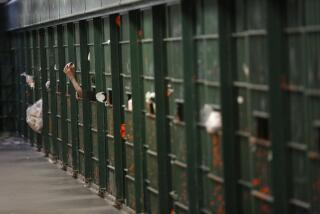Eyes Averted
- Share via
The Martin Luther King Jr./Drew Medical Center opened in 1972 to serve South Los Angeles neighborhoods that had been shunned by white doctors. It was supposed to be a symbol of Los Angeles’ commitment to right the wrongs that had led to the Watts riots. Three decades later, it is a symbol indeed. It symbolizes a black community leadership that cares more about symbols than reality and a political establishment that is too afraid of a fuss from local leaders to do what is right for poor and minority patients.
But King/Drew is not just a symbol. It is also a real-life hospital so incompetent that it is as much a threat as a boon to the community it is supposed to serve. The Los Angeles County Board of Supervisors, which bears primary responsibility, would never let this happen to patients on the Westside or in the San Fernando Valley.
As dramatically demonstrated by the series that begins today on Page A1 of The Times, King/Drew is literally killing people.
A Long List of Victims
The stories are heart-rending:
Nine-year-old Dunia Tasejo escaped with only a couple of broken teeth when she was sideswiped by a car. Then the ambulance delivered her to King/Drew. Paralyzed by an overdose of sedatives, removed prematurely from a ventilator and left unmonitored, the second-grader died.
Oluchi McDonald, a 20-year-old college student, was found on the floor, unconscious, in a pool of his own vomit 17 hours after entering King/Drew. He died an hour later of gangrene of the intestine, without having undergone diagnostic tests much beyond taking his pulse and blood pressure.
Sherry Ridley, a 43-year-old airport security guard and mother of two sons, had elective surgery for ovarian cysts. A physician trainee stitched through her colon, then a second trainee was unable to fix the first mistake. A senior surgeon operated eight more times in the next few weeks as Ridley, swollen with fluids, ballooned by 140 pounds and then died.
Patricia Arellano, 11, entered King/Drew’s ER with abdominal pain, and her appendix was removed. Later that night she died of a rare but highly treatable inflammation of the pancreas. There had been nothing wrong with her appendix.
Angel Ayala, just 8 months old, was carried into the emergency room of King/Drew with a fever and seizures and left a week later just as sick. Weeks later he was found by another hospital to have irreversible brain damage from an undiagnosed but treatable viral infection. Today he cannot see, talk or walk.
Tragic accidents happen at even the best hospitals. But King/Drew is widely acknowledged to be among the worst.
It is one of just seven medical facilities in the United States that faced a total loss of accreditation this year, and that is just the latest insult from accrediting groups and from federal agencies that finance half of King/Drew’s budget.
Yet the reaction is always the same. A few South Los Angeles politicians accuse an overzealous news media (that would be this newspaper, among others) of exaggerating run-of-the-mill problems that wouldn’t get so much attention in a white-run hospital.
County Supervisors’ Failure
Other local pols and neighborhood leaders in the rest of the city remain silent. Are they ignorant of conditions at King/Drew, or indifferent to them?
County supervisors, who are supposed to be running the place, express shock and outrage every time some scandal makes news. Apparently the supervisors would rather be thought of as utter failures in their duty to supervise than to be considered politically insensitive.
The supervisors woke up a bit this fall. Over the protests of an angry black community, which had a point in objecting that the decision had been made in secret and therefore was illegal, they ordered the busy trauma unit shut down so that doctors and nurses could devote more time to basic care. They hired an outside management team to take over the hospital’s day-to-day operations and begin a top-to-bottom overhaul.
Experts from across the country agree that these are the right first steps. The one-year management contract bought the supervisors some time.
But in the history of King/Drew, more time has been just an opportunity for procrastination.
In 1989, an editorial appeared on this page titled, “Even Worse Than We Knew.” It accompanied a Times investigation of shockingly substandard medical care at King/Drew. As the headline suggested, King/Drew already had a bad reputation. Today, that reputation is worse than it was 15 years ago. But it is still not as bad as the reality.
The hospital near Watts was supposed to be a source of pride. King/Drew is a source of shame -- not just for people in the neighborhood but for everyone in this city. No one with a choice would go there for medical care. As both symbol and reality, it is separate and unequal -- the very injustice it was supposed to cure. The only form of justice it provides is a parody of justice: the right of black people to die in a black hospital.
More to Read
Sign up for Essential California
The most important California stories and recommendations in your inbox every morning.
You may occasionally receive promotional content from the Los Angeles Times.










